Hands up if you’re guilty of neglecting your core and pelvic floor muscles?
It seems you’re not alone, with a large percentage of women failing to maintain any kind of strength as we age, especially after having children. It’s no wonder the mid-section is the area of our bodies we obsess over the most.
When we’re young, it’s easy to get away with not giving too much thought to our core muscles. But as soon as the years start creeping up and we become increasingly sedentary after carrying and giving birth to little humans, inactivity and gravity force us to sit up (literally) and take notice.
This is why women have different needs when it comes to core fitness and pelvic floor health. Having a weak core can contribute to imbalances of the hips, back pain and pelvic floor issues.
So what exactly is ‘the core’ anyway?
When we refer to ‘the core’, we’re referring to the whole shebang that makes up the muscle groups that wrap around our mid-section like a corset. There’s the rectus abdominis, external obliques, internal obliques, tranverse abdominis, plus the muscles of the lower back, pelvic floor and hips. Whoah, the core is HUGE!
So, back to our pelvic floor. It’s super-important we choose exercises that not only work our pelvic floor muscle (they keep everything nice and supported, like a hammock around our spine and play a huge role in bladder and bowel control), but the core as a whole. I prefer to do these through functional exercises that are more specific to the movements and tasks we are likely to carry out each day, while focusing on specifically activating the pelvic floor.
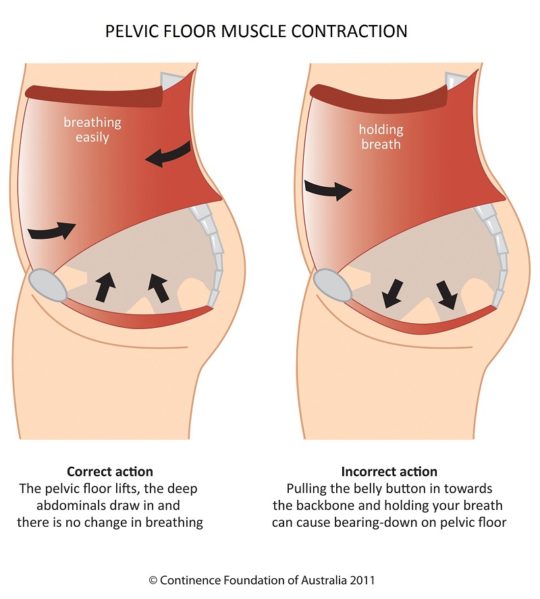
Activating the pelvic floor
How do you know if you’re activating the pelvic floor, I hear you say?
Try this right now while you’re sitting there reading. On an exhale, draw the sitting bones up and in – this is like you are pulling your belly button to your spine, then close the muscles that stop the flow of wee wee while trying not to engage your outer abdominal muscles. Imagine a zipper being done up from the base of the spine to around the lower ribs. Don’t let your ribs flare and try to breath into the side of your ribs rather than puff your chest. This will give you a fairly good idea of what they are and what shape they’re in.
It’s important to concentrate on switching on (and off) these pelvic floor muscles while you’re completing any type of abdominal work. Without proper recruitment and already weakened muscles, you can actually place strain on abdominal organs (including the bladder and bowel) or worse still, prolapse. Knowing how to relax your pelvic floor muscles is just as important as knowing how to switch them on. Constantly bracing your pelvic floor and core and having them ‘on’ all day will only lead them to being rigid, stiff and too fatigued to do their job properly!
5 pelvic floor strengthening exercises every woman should do
With these exercises, we’re looking to incorporate the core while focusing on engaging our pelvic floor through functional movements that are strengthening our back, glutes, hamstrings, hips and abdominals. You may be fooled into thinking these exercises are basic but, with the correct activation, they can be challenging to even the fittest.
1. The bridge
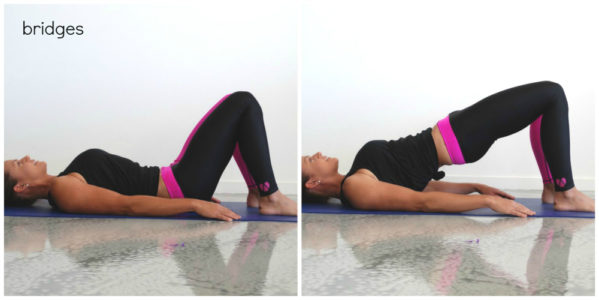
Great for core stabilisation and awareness.
1.Lie on your back with your arms by your sides, knees bent, and feet flat on the floor and under your knees. Switch on your abdominal and buttock muscles.
2. Raise your hips to create a straight line from your knees to shoulders. Activate your core and try to pull your belly button in toward your spine. If your hips sag or drop, lower yourself back on the floor.
3. Try to maintain a straight line from your shoulders to your knees and hold for 20-30 seconds. You may need to begin by holding the bridge position for a few seconds as you build your strength. It’s better to hold the correct position for a shorter time than to go longer in the incorrect position. As you lower yourself, try to do it one vertebra at a time until you are back to neutral position on the floor. Repeat 10-12 times.
2. Laying engaged twists

Great for engaging pelvic floor while moving through a functional twist.
1.Lying on your back, roll a Swiss ball under your calves. Place your arms next to your body
2. With bent legs, try turning the ball slowly to the left and right, without the lower back or tailbone losing contact with the mat or floor. On your exhale, switch on your pelvic floor and return to the start position. This is a controlled movement. After 8-10 repetitions, take a short rest, then repeat the exercise sequence.
3. Alternate arm/leg lifts
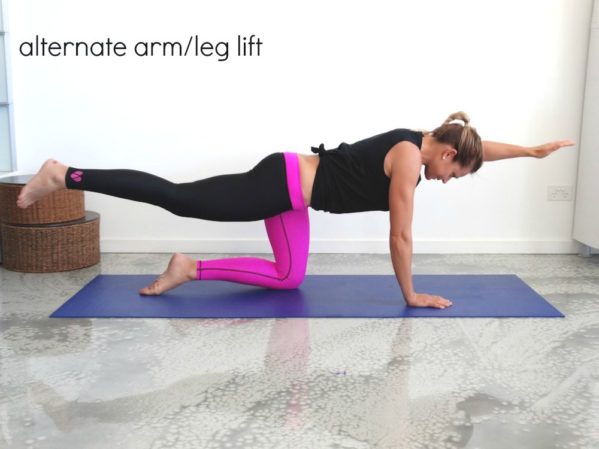
Builds back strength while engaging core.
1.On a mat, position yourself on your hands and knees. Slowly draw in your navel up towards your spine while keeping your chin tucked in.
2. Raise your arm and extend your opposite leg behind you, remembering to keep your back flat. Keep your arm and leg straight, lifting both up until they are in line with your back. Hold the top position for a few seconds and slowly return to the starting position. Repeat with the opposite arm and leg, alternating sides.
4. Seated leg lift on ball
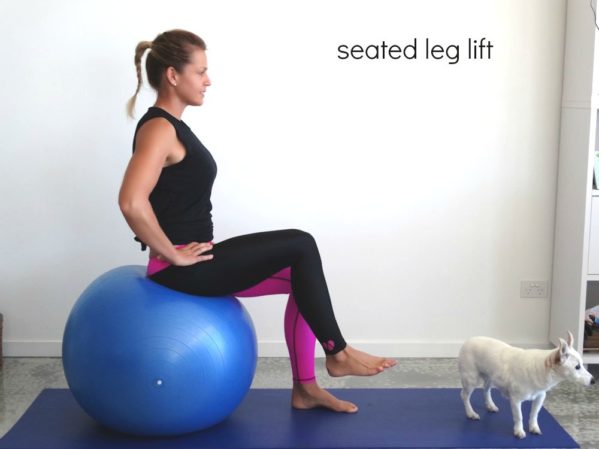
Brings awareness to pelvic floor muscle.
1.Sitting with a neutral spine on a Swiss ball, lengthen the distance between your belly button and sternum to engage your core muscles.
2. Begin with both knees bent at 90 degrees and feet flat on the ground. Keeping your back straight, raise one foot off the ground, maintaining balance and keeping your knee at 90 degrees. Try not to lean back as you do this. Hold for five seconds and then place it back on the ground. Repeat with the other leg and alternate 10-12 times, then repeat.
5. Wall pushes
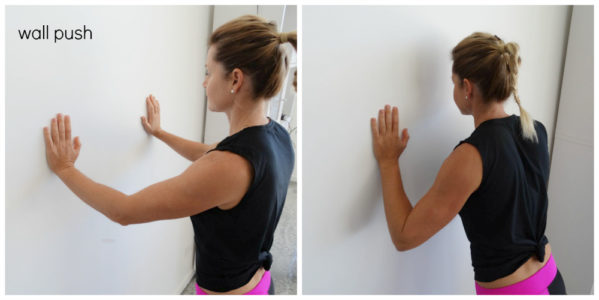
Works chest, shoulders, triceps and core.
1.Place your hands shoulder-width apart on a sturdy wall in front of you, feet slightly apart, abs engaged, back and legs straight.
2. Lean forward slightly so most of your weight is on your arms, keeping elbows tucked in. Inhale as you bend your elbows and lean your body further towards the wall, maintaining a long, straight line from head to toe.
3. Push back out to the start position and repeat 10-12 times, then repeat.
Of course you should be keeping in mind that with every resistance exercise you perform that you are not isolating certain muscle groups but rather working the body as a whole system. By viewing the body as a whole, with energies free flowing and posture is of utmost importance (focused on shoulders back and down, chest out, chin up, stomach in and feeling like you are being pulled from head to toe) we enable our nervous system to recruit the correct muscle fibres and add tone.
What exercises do you do regularly to keep your core in check?



